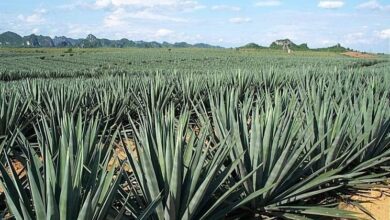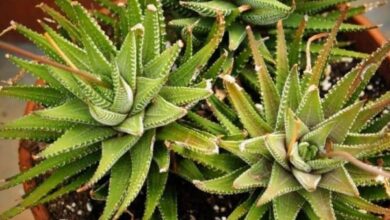Why do you put the Aloe Vera or Aloe Vera gel pink or purple?

Many people ask me why the aloe vera gel they have obtained from a beautiful and healthy plant turns pink, purple and even reddish. Do you want to know if you can apply pink aloe vera gel on your skin? Wondering if it is safe to ingest pink aloe vera gel? Or maybe because aloe vera gel turns purple?
It’s not because of pathogenic bacteria, it’s not because of beneficial bacteria, so what is it? In my opinion, it is due to the vitamin B12 inside the leaves.
This I was recently asked:
Hi
I have been using Aloe Vera on my skin for years, but it was always from a plant my mother had, which had a clear gel (sometimes very light yellow in color) that I know is normal.
But when I bought a plant, I opened it up and it had a clear gel, but also a purple «liquid,» kind of like a purple juice on the leaf walls, not the gel . This is normal? And is it okay to use this plant for skin care, sunburn, etc.?
Best regards
Sara.
Well, to answer this question I needed a whole article, so finally this is my answer for Sara and for anyone interested in this important fact about Aloe Vera gel.
Below, I have developed a short, but clear article where I explain what I have discovered about why Aloe Vera gel (and therefore any juice, cream or lotion from it) changes color towards pink tones.
Why does the Aloe Vera gel turn purple?
First, let’s talk about something that does NOT cause the color difference in Aloe Vera gels : Pathogenic bacteria.
It is not because of pathogenic bacteria.
When you buy fresh organic vegetables, you not only get the plants, but also the natural bacteria. Many people would say that this is not a problem at all, but that eating raw and live food brings many benefits. So the most important questions to ask about raw foods are:
- How much bacteria is present? There are certain levels of bacteria that are acceptable, and there are levels that are not. If you buy a salad and leave it in the refrigerator for too long, eventually your sight, smell, and taste will let you know that the bacteria levels have gotten too high . Rot occurs due to bacteria, and you don’t need a scientist to tell you when that process has become too advanced.
- What strains are present? Some bacteria are beneficial, some are harmful (pathogenic), and some have no real effect on the human body, being rapidly destroyed in the intestine and turned into waste. What we will always try to avoid are pathogenic bacteria, for example, certain strains of E. coli .
This E. coli bacteria are not found naturally in vegetation, but can be transferred to plants from animal feces. Can E.coli bacteria change the color of our Aloe Vera gels or leaves towards pink tones?
It’s funny how one of the ways in which nature protects Aloe Vera is by providing plants with pointed spurs , like cacti, that tell animals «Stay away!» On the other hand, if an animal tastes a raw Aloe leaf it will have vomiting and diarrhea due to the aloin or Aloe latex .
Thanks to this natural protection of plants, it is rare for animals to deposit their feces on or near the plant. And if you grow them at home, it is much less likely.
In this way we can say that any Aloe Vera gel that reaches our hands is free of harmful bacteria and therefore, these are NOT the cause because the aloe vera turns pink .
Let’s keep investigating more bacteria …
It is not due to beneficial bacteria
The beneficial bacteria are called «probiotics» and they are healthy for you. The L. acidophilus bacteria is a well-known strain of probiotic bacteria. Sometimes in vegetables, bacteria are nurtured and cultivated to naturally preserve and enhance many health benefits.
But can these good bacteria make our Aloe Vera gel, and even the entire plant, pink or purple?
Should I only eat pasteurized or irradiated food? Some bacteria are good for you and some are not. Pasteurization (elevated temperatures) and irradiation (exposure to radiation) kill both types indiscriminately; Furthermore, these processes can change the internal structure of food and make it much less valuable to your health.
As a general rule, the closer to the natural state of food, the better it will be for our health.
How do bacteria affect the viscosity of aloe vera? As the bacteria consume the mucopolysaccharides, the viscosity of the aloe vera gel decreases. Aloe starts quite viscous crude, however , after 2-3 weeks in the refrigerator, the bacteria count increases and decreases mucopolysaccharides.
In other words, these good bacteria make our Aloe Vera gels, juices, creams or lotions less thick but not more pink or purple.
So why does Aloe vera turn pink or purple?
This has been a question that has plagued me for quite some time as I have cut fresh Aloe leaves and seen portions turn pink before my eyes. I have also seen pink Aloe Vera turn translucent again, right in front of my eyes; – «I swear!»
Most people who experiment with raw Aloe Vera say that the color change is related to a rapid change in temperature . However, this is also something that I have not been able to duplicate, even subjecting the fresh filleted leaves to rapid cooling.
I have also observed color changes in the leaves of the Aloe Vera plants themselves and surely you too. The leaves are generally green, but often appear quite red, purple, or pink. This seems to be the case when they get plenty of sunlight, although there are other causes. Light can certainly be a catalyst in chemistry. For more information on external color changes in the Aloe Vera plant visit this essential article here .
Is it the fault of vitamin B12?
An interesting observation from the labs is that certain nutrients change color when converting from one form to another, and vitamin B12 is associated with the colors pink and red.
It is a fact Aloe Vera provides significant levels of B12. I don’t know if B12 is a factor, and I’m certainly not making the claim, however it is an interesting possibility, one that needs further study.
Do you think that vitamin B12 can make an aloe plant and its gel turn purple or pink?
My own Experiment:
I made my own batch of aloe vera a few days ago. 3 in 30 milliliter bottles to be exact – all from the same plant that I have had in the same pot and in the same place for almost 2 years. I kept them in plastic travel bottles (opaque color) and washed them first. These bottles have a pump that minimizes contact with skin and air to avoid contamination.
- The first batch remained clear, although it still had some bits of green scraped off the leaves.
- The second batch turned a little pink on top after a day and spread a bit, but took no more than 1/5 of the bottle.
- The third batch looked light too, but after the first day I noticed pink streaks across the top. On day 2 and 3 it completely spread throughout the entire bottle and even turned darker pink, almost purple. Also its smell increased and it became less sticky; a substance more like water.
Conclusions
There is no scientific data on identified bacterial toxification based on color. Instead, a note of caution could be that the purple or pink gel could stain or color your skin. Therefore, it is best to avoid using colored aloe vera for skin repair or ingestion. Instead, I would use the pink or purple aloe to condition, moisturize, or remove dandruff: Nothing else.
My advice is to keep the gel refrigerated to keep the bacteria count to a minimum and not for more than 10 days. Here’s a good article on how to keep it longer .
All of the above applies to the pink, red, orange, and purple stripes. As for the brown or black colors – be careful as we can speak of very high levels of bacteria probably due to rot. See my article on Aloe Vera pests and diseases to learn more about this.
On the other hand, if we talk about the external appearance of the plant, you should read my article on why an aloe turns brown.




